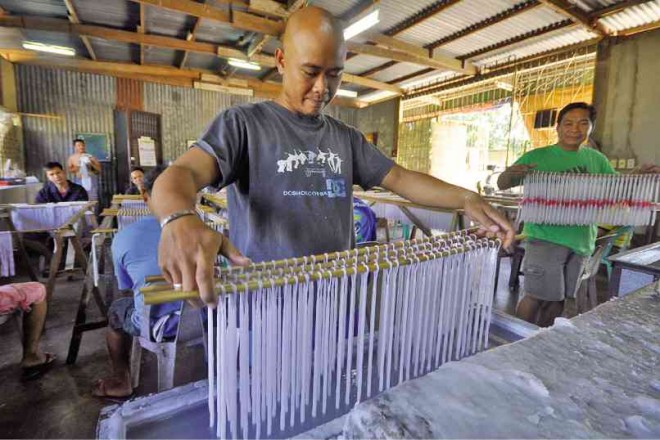
A WORKER dips the wicks hanging on a stick into molten wax until the desired candle weight is attained. WILLIE LOMIBAO/INQUIRER NORTHERN LUZON
MANAOAG, Pangasinan—In a backyard candle factory in Barangay (village) Baritao in Manaoag town, Pangasinan province, workers are producing thousands of candles of varying sizes year-round for pilgrims visiting the Minor Basilica of Our Lady of the Rosary of Manaoag.
Michael Dioso, supervisor of the factory run by the Shrine of Our Lady of Manaoag Multipurpose Cooperative, an organization of some 100 church employees, said factory production usually rises during Lent, its peak season.
The 11 regular employees work eight hours a day but have shorter workweeks during the rainy season when only a few pilgrims visit Manaoag and the demand for candles dwindles. At least 5,000 pilgrims visit the church on Sundays to hear Mass, with many of them offering prayers after lighting candles at the candle gallery at the back of the church.
Set up five years ago in a rented workshop inside a church-owned compound in the town, the factory produces five types of candles. “They are all white, 8 inches long. They just differ in weight,” Dioso said.
The cheapest candle, sold at P4, weighs 15 grams. A 30-gram candle costs P8; 40-gram candle, P9; 80-gram candle, P15; and 110-gram candle, P20.
PILGRIMS light candles and offer prayers in the candle gallery at the back of the Minor Basilica of Our Lady of the Rosary of Manaoag in Pangasinan province. WILLIE LOMIBAO/INQUIRER NORTHERN LUZON
Except for a cutting tool run by an electric motor, the candles are made manually.
The production line begins from a corner where a worker measures and cuts ordinary strings for the wicks. These are hung on a stick and quickly dipped into the vat of molten wax.
The wicks are transferred and hung on another stick 30 wicks at a time.
A worker can hold three sticks and dip the wicks repeatedly in the vat of molten wax until the desired weight of the candles is attained.
After drying them for about 15 minutes, the candles go to the labeling section. Before packing the labeled products in boxes, the lower ends are cut using an electric cutter to flatten them.
“This undertaking has been a big help to village residents. Of course, this is an income generating project for the cooperative,” Dioso says.